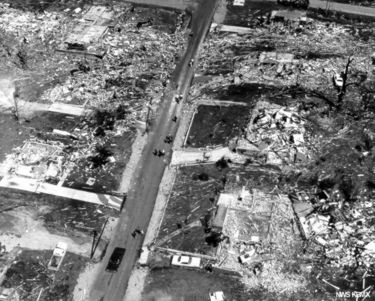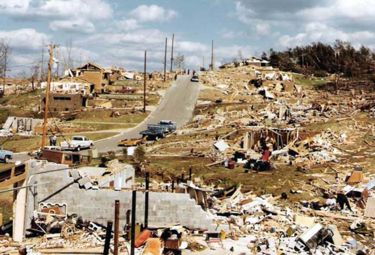1977 North Smithfield tornado: Difference between revisions
No edit summary |
No edit summary |
||
| (6 intermediate revisions by 2 users not shown) | |||
| Line 1: | Line 1: | ||
The '''1977 Smithfield tornado''' struck the northern suburbs of the [[Birmingham]] during the afternoon of [[April 4]], [[1977]]. | [[Image:1977 Smithfield tornado damage 2.jpg|right|thumb|375px|View of Smithfield after the tornado.]] | ||
[[Image:1977 Smithfield tornado damage.jpg|right|thumb|375px|Overview of damage midway through the tornado's track, just east of [[U.S. Highway 78]].]] | |||
The '''1977 North Smithfield tornado''' struck the northern suburbs of the [[Birmingham]] during the afternoon of [[April 4]], [[1977]]. | |||
Beginning just a few miles north of downtown [[ | Beginning just a few miles north of downtown [[Birmingham]] near [[Tarrant]], the tornado proceed north through northern [[Jefferson County]] producing F5 damage in the community of [[North Smithfield]], also known as [[Hayes Highland]], north of [[Sayreton]]. The tornado was blamed for 22 deaths and more then 125 injuries while damage was estimated at $15 million dollars. Hundreds of homes were completely destroyed while [[Daniel Payne College]] suffered extensive damage and was forced to close. Many residents were able to seek shelter thanks to a newly-implemented NOAA Weather Radio program in the area. | ||
In addition to this tornado, several other tornadoes were reported from the same system in the Midwest, [[Alabama]], | In addition to this tornado, several other tornadoes were reported from the same system in the Midwest, [[Alabama]], Georgia, Mississippi and North Carolina. One tornado in Floyd County, Georgia killed one person while another fatality was reported east of Birmingham in [[St Clair County]]. | ||
The F5 tornado touched down near the end of the path of two other violent tornadoes that struck the Birmingham region in 1956 and in [[ | The F5 tornado touched down near the end of the path of two other violent tornadoes that struck the Birmingham region in [[1956 Birmingham tornado|1956]] and in [[1998 Oak Grove tornado|1998]]. In [[1998]], [[1998 Tarrant tornado|another F5]] started north of [[Tuscaloosa]] before ending southwest of Tarrant after killing 32. The [[1956]] [[1956 Birmingham tornado|F4 tornado]] which followed a similar path through Birmingham killed 25. | ||
Dr Theodore Fujita, creator of the Fujita scale used to indicate tornado intensity, personally followed this storm supercell from an airplane tracking the tornado. After surveying the damage, Fujita considered giving it an F6 ranking before deciding on F5. | |||
==References== | ==References== | ||
* " | * NWS-Birmingham Internet Services Team (March 30, 2007) "[http://www.srh.noaa.gov/bmx/?n=event_04041977 April 4, 1977, Smithfield F5 Tornado]." National Weather Service Forecast Office, Birmingham, AL | ||
* "[http://en.wikipedia.org/wiki/April_1977_Birmingham_tornado April 1977 Birmingham tornado]" Wikipedia, The Free Encyclopedia - accessed June 6, 2009 | |||
==External links== | ==External links== | ||
* [http://www.tornadohistoryproject.com/tornadomap.php?yr=1977&mo=4&day=4&st=%25&fu=%25&co=&l=500&submit=Search&format=basic&p=1&s=1 Map of April 4, 1977 tornadoes] | * [http://www.tornadohistoryproject.com/tornadomap.php?yr=1977&mo=4&day=4&st=%25&fu=%25&co=&l=500&submit=Search&format=basic&p=1&s=1 Map of April 4, 1977 tornadoes] | ||
[[Category:1977 events|Tornado]] | [[Category:1977 events|Tornado]] | ||
[[Category:Weather events]] | [[Category:Weather events]] | ||
[[Category:North Smithfield]] | |||
Latest revision as of 12:45, 4 April 2015

The 1977 North Smithfield tornado struck the northern suburbs of the Birmingham during the afternoon of April 4, 1977.
Beginning just a few miles north of downtown Birmingham near Tarrant, the tornado proceed north through northern Jefferson County producing F5 damage in the community of North Smithfield, also known as Hayes Highland, north of Sayreton. The tornado was blamed for 22 deaths and more then 125 injuries while damage was estimated at $15 million dollars. Hundreds of homes were completely destroyed while Daniel Payne College suffered extensive damage and was forced to close. Many residents were able to seek shelter thanks to a newly-implemented NOAA Weather Radio program in the area.
In addition to this tornado, several other tornadoes were reported from the same system in the Midwest, Alabama, Georgia, Mississippi and North Carolina. One tornado in Floyd County, Georgia killed one person while another fatality was reported east of Birmingham in St Clair County.
The F5 tornado touched down near the end of the path of two other violent tornadoes that struck the Birmingham region in 1956 and in 1998. In 1998, another F5 started north of Tuscaloosa before ending southwest of Tarrant after killing 32. The 1956 F4 tornado which followed a similar path through Birmingham killed 25.
Dr Theodore Fujita, creator of the Fujita scale used to indicate tornado intensity, personally followed this storm supercell from an airplane tracking the tornado. After surveying the damage, Fujita considered giving it an F6 ranking before deciding on F5.
References
- NWS-Birmingham Internet Services Team (March 30, 2007) "April 4, 1977, Smithfield F5 Tornado." National Weather Service Forecast Office, Birmingham, AL
- "April 1977 Birmingham tornado" Wikipedia, The Free Encyclopedia - accessed June 6, 2009
